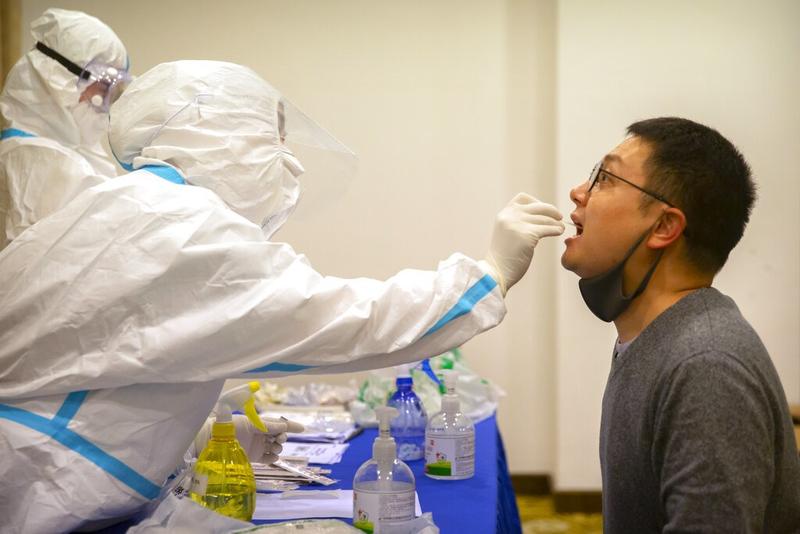 A worker in a protective suit takes a throat swab sample for a COVID-19 test in Wenchang, Hainan province, Nov 22, 2020. (MARK SCHIEFELBEIN / AP)
A worker in a protective suit takes a throat swab sample for a COVID-19 test in Wenchang, Hainan province, Nov 22, 2020. (MARK SCHIEFELBEIN / AP)
BEIJING/SHANGHAI - Shanghai authorities have carried out nucleic acid testing for staff workers at the Shanghai Pudong International Airport after several confirmed COVID-19 cases cases were linked to airport personnel.
Addressing a regular press briefing on Monday on the city's COVID-19 control situation, Zhou Junlong, vice president of the Shanghai Airport Authority, said nucleic acid test results of 11,544 freight transport personnel at the airport were negative, and swab samples of another 6,175 staff members are still being examined.
Zhou Junlong, vice president of the Shanghai Airport Authority, said nucleic acid test results of 11,544 freight transport personnel at the airport were negative, and swab samples of another 6,175 staff members are still being examined
He added that the confirmed locally transmitted COVID-19 cases reported recently are related to personnel in the airport's freight transport area and do not involve the passenger transportation section.
The airport authority is carrying out disinfection of the affected area and has reinforced protection measures for staff with the implementation of close supervision of cold-chain food operation area, Zhou said.
All personnel working at the airport's cargo terminals and cargo areas underwent nucleic acid tests from Sunday evening to Monday morning, according to the Shanghai Airport Authority.
Quarantine workers set up a temporary testing area in an airport parking lot to carry out on-site swab sample collection and testing.
So far, five freight transport staff at the airport have been confirmed positive for COVID-19. Among them, the wives of two of the staffers have also been confirmed infected.
By Monday morning, authorities have tracked 55 close contacts, placing them under quarantine, and screened 2,541 others based on an official epidemiological investigation. They have all tested negative for nucleic acid testings.
Samples of food, objects and environment linked to the confirmed cases have been collected and all of them have been found negative in nucleic acid tests.
Xu Jin, deputy director of the Shanghai municipal administration for market regulation, said after the cluster of confirmed locally-transmitted COVID-19 cases emerged, authorities checked more than 177,000 food businesses. More than 130,000 cold-chain food samples were collected and all tested negative for COVID-19.
According to the press briefing, the earliest two confirmed airport freight staffers did not have contacts with imported cold chain food. Their source of infection is assumed to be exposure to imported aviation containers from overseas.
The moves came as two domestically transmitted cases were reported in Shanghai on Sunday.
The two local cases were among the 11 fresh infections reported on the Chinese mainland on Sunday, the National Health Commission said Monday.
There were nine newly reported imported cases on the mainland on Sunday, of which four were posted in Guangdong while Beijing, Tianjin, Shanghai, Fujian and Shaanxi saw one case each, the National Health Commission said
The other nine newly reported cases were imported, of which four were posted in Guangdong, and one each in Beijing, Tianjin, Shanghai, Fujian and Shaanxi, the commission said in its daily report.
There were no new suspected cases or additional deaths related to the disease reported, it said.
Another 12 patients were discharged from hospitals after recovery, while 315 others were still undergoing treatment, of whom six were in severe condition, according to the commission.
ALSO READ: China tightens COVID-19 prevention in blood donations
By the end of Sunday, a total of 3,784 imported cases had been reported on the mainland. Among them, 3,486 had been discharged from hospitals after recovery while 298 remained hospitalized. No deaths from the imported cases had been reported.
Overall, a total of 86,442 confirmed cases had been reported on the mainland, including 81,493 recoveries and 4,634 deaths, the commission said.
There were no suspected cases on the mainland, while 11,231 close contacts were still under medical observation after 731 were released from observation, according to the commission.
Also on Sunday, 10 new asymptomatic cases, all arriving from outside the mainland, were reported and one asymptomatic case was re-categorized as a confirmed case.
The commission called for unremitting efforts to ensure COVID-19 containment measures were implemented to prevent a rebound of the pandemic in winter and spring
There were 357 asymptomatic cases still under medical observation, with 353 arriving from outside the mainland.
READ MORE: One more Chinese vaccine enters late-stage human trials
By the end of Sunday, 5,628 confirmed cases, including 108 deaths, had been reported in the Hong Kong Special Administrative Region (SAR), while the Macao SAR had recorded 46 cases, and Taiwan had registered 617 cases, including seven deaths.
A total of 5,259 patients in the Hong Kong SAR, 46 in the Macao SAR and 548 in Taiwan had been discharged from hospitals after recovery.
Risk of virus resurgence in winter
The commission called for unremitting efforts to ensure COVID-19 containment measures were implemented to prevent a rebound of the pandemic in winter and spring, urging local authorities to step up epidemic monitoring and reporting.
Nucleic acid testing should be expanded to cover more people who need to be tested, the commission said at a recent teleconference, demanding an increased frequency of regular testing.
READ MORE: China expands its arsenal in COVID-19 battle
Efforts should go into the monitoring, reporting and transferring of COVID-19 cases identified at fever clinics, and medical institutions must not cover up the truth, the commission said.
It also called for measures to prevent imported cases from abroad and nosocomial infection, strengthen emergency responses to tackle cluster outbreaks and step up for epidemic prevention and control around the Spring Festival period.


